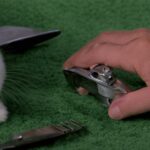Clipping a dog’s nails is not just about aesthetics, it’s also crucial for their health and well-being. Long nails can cause pain and discomfort, and even lead to infections and gait abnormalities. To safely and effectively trim your dog’s nails at home, it’s important to find the quick, which is the sensitive part of the nail that contains blood vessels and nerves. This article will provide a step-by-step guide on how to find the quick on dog nails, along with expert tips and tools to make the process easier.
Key Takeaways:
- Locating the quick on dog nails is essential for safe and effective nail trimming.
- The quick is the sensitive part of the nail that contains blood vessels and nerves.
- Understanding the anatomy of a dog’s nail will help you identify the quick.
- There are tools available, such as quick finders, to assist in locating the quick on dog nails.
- Professional guidance and positive reinforcement techniques can contribute to successful nail trimming.
The Importance of Clipping Dog’s Nails Regularly
Regular nail trimming is crucial for the health and well-being of dogs. It goes beyond just aesthetics; it plays a vital role in their overall comfort and mobility. Failure to keep their nails at an appropriate length can lead to various issues like pain, discomfort, infections, and even gait abnormalities.
By clipping your dog’s nails regularly, you can prevent these problems from occurring. Properly trimmed nails help maintain healthy paw structure and reduce the risk of nails breaking or splitting. Additionally, regular nail trimming ensures that your dog’s posture and gait remain unaffected, allowing them to move comfortably and freely.
It is recommended to incorporate nail trimming into your dog’s grooming routine. By making it a regular practice, you are guaranteeing their comfort and preventing any potential health problems associated with long nails. Remember, a little bit of effort in clipping their nails goes a long way in keeping your furry friend happy and healthy.
Benefits of Regular Nail Trimming:
- Prevents pain and discomfort
- Reduces the risk of infections
- Maintains healthy paw structure
- Enhances posture and gait
- Prevents nails from breaking or splitting
Regular nail trimming is a simple yet essential aspect of your dog’s overall grooming routine. By understanding the importance of this practice and incorporating it into your pet care regimen, you can ensure your dog’s comfort, well-being, and happy paws.
| Benefits of Regular Nail Trimming | |
|---|---|
| Prevents pain and discomfort | 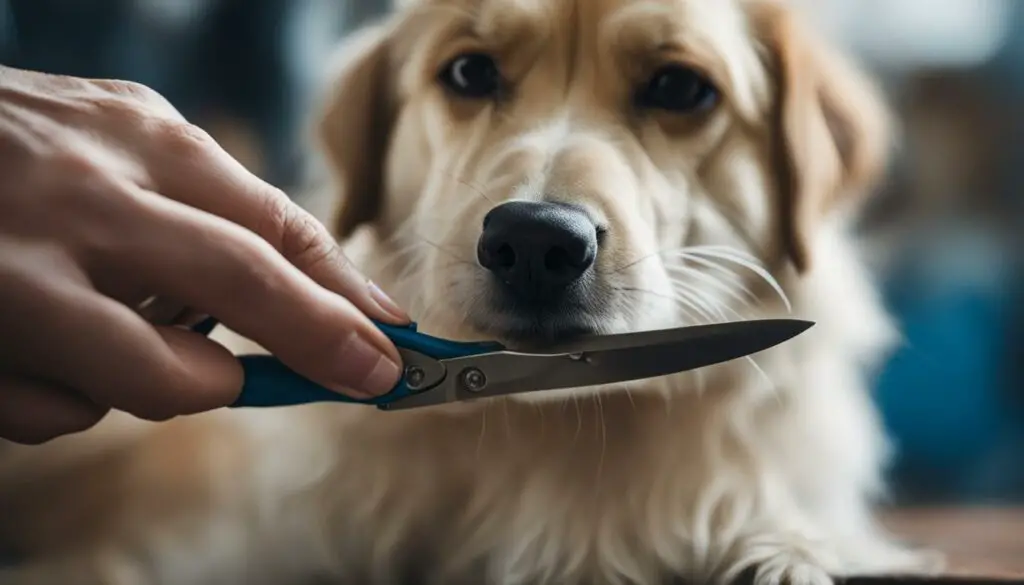 |
| Reduces the risk of infections | |
| Maintains healthy paw structure | |
| Enhances posture and gait | |
| Prevents nails from breaking or splitting |
Understanding the Anatomy of a Dog’s Nail
Before you start trimming your dog’s nails, it’s important to understand the anatomy of a dog’s nail. Each nail consists of several parts that play a vital role in its structure and function.
The main components of a dog’s nail include:
- Hard outer shell: This is the visible part of the nail that we see and trim. It provides protection and support to the nail.
- Quick: The quick is the sensitive part of the nail that contains blood vessels and nerves. Cutting into the quick can cause pain and bleeding. It is crucial to avoid cutting into the quick while trimming your dog’s nails.
- Nail bed: The nail bed is the portion of the nail that attaches it to the underlying bone. It helps in the growth and stability of the nail.
The quick is usually more visible in dogs with light-colored nails, as it appears as a pinkish area. However, it can be more challenging to identify in dogs with dark-colored nails. In such cases, it is recommended to trim small amounts of the nail at a time or use specialized tools to help locate the quick.
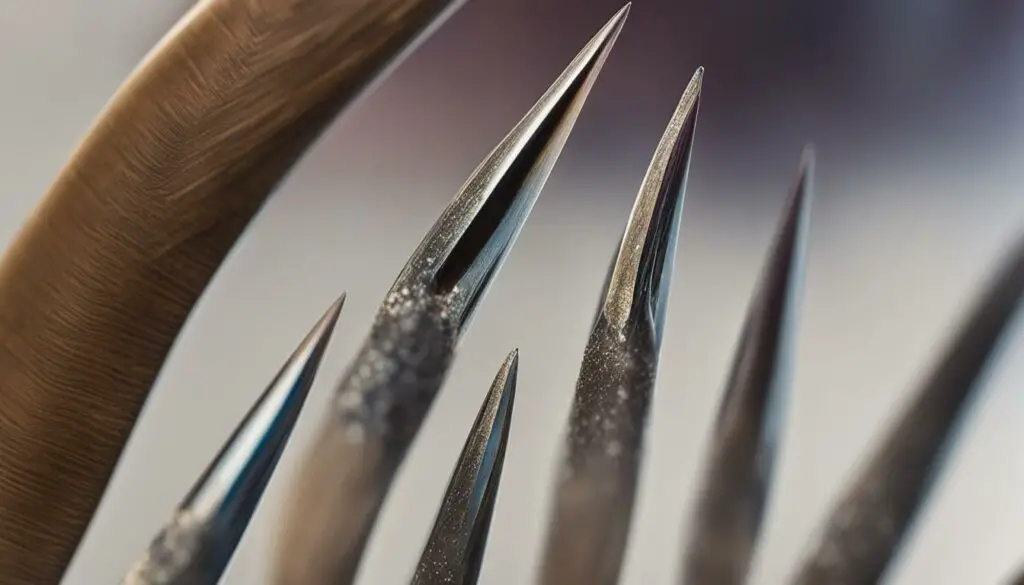
Benefits of Understanding the Nail Anatomy
Understanding the anatomy of a dog’s nail is essential for safe nail trimming. It helps you locate the quick accurately and avoid any pain or discomfort for your furry friend. By being familiar with the different parts of the nail, you can also ensure that you trim the nails to an appropriate length, promoting your dog’s comfort and overall paw health.
Tips for Finding the Quick on Dog Nails
Finding the quick, the sensitive part of a dog’s nail, can be a challenging task, especially for dogs with dark-colored nails. However, with the right techniques and tools, it is possible to locate the quick and trim your dog’s nails safely. Here are some tips to help you in the process:
- Examine the nail: Carefully inspect the nail to identify any subtle color changes or translucent areas. The quick is often visible as a pinkish or grayish area within the nail.
- Use a flashlight: For dogs with dark-colored nails, shining a flashlight through the nail can help illuminate the quick. This technique makes it easier to see the quick’s location and avoid cutting into it.
- Trim gradually: If you’re unsure of the exact location of the quick, it’s best to trim a small portion of the nail at a time. This approach allows you to be cautious and avoid cutting into the sensitive area.
- Take breaks: If your dog becomes anxious or uncomfortable during the nail trimming process, take breaks to allow them to relax. Maintaining a calm and stress-free environment will make it easier to find the quick and trim the nails safely.
Remember, the key to finding the quick on dog nails is patience and practice. As you become more familiar with your dog’s nail anatomy and observe their reactions, you’ll develop a better understanding of where the quick is located. Additionally, using specialized tools such as a quick finder can provide visual guidance and assist in locating the quick accurately.
By following these tips for safe nail trimming and finding the quick, you’ll be able to maintain your dog’s nail health and prevent any discomfort or injuries. Always prioritize your dog’s well-being and consult a professional if you’re unsure or need further guidance in the nail trimming process.
Expert Tip: Quick Finder Tools
If you’re struggling to find the quick on your dog’s nails, consider using quick finder tools specifically designed for this purpose. These tools use LED lights and sensors to detect the quick’s location, making it easier for pet owners to identify and avoid cutting into the sensitive area. Quick finder tools provide an additional layer of assurance and can be valuable resources for safe and precise nail trimming.
Essential Tools for Finding the Quick on Dog Nails
When it comes to safely and effectively finding the quick on your dog’s nails, having the right tools can make all the difference. These essential tools will help you locate the quick with precision and confidence, ensuring a stress-free nail trimming experience for both you and your furry friend.
Nail Clippers
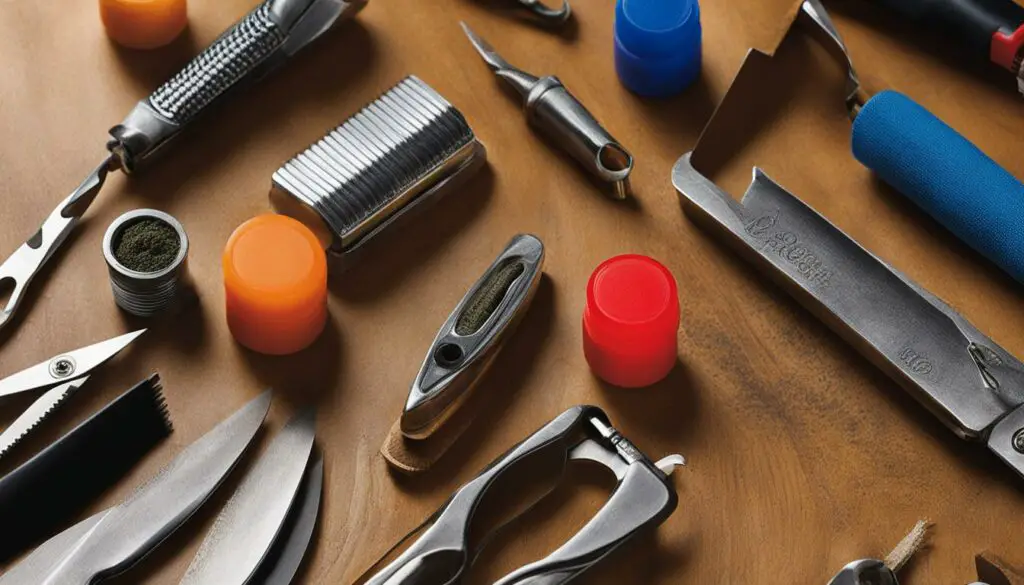
Nail clippers are a must-have tool for trimming your dog’s nails. Look for clippers specifically designed for dogs, as they are designed to cut through the thicker nails of our canine companions. There are two main types of nail clippers for dogs: guillotine clippers and scissor clippers. Whichever type you choose, make sure they are sharp and in good condition to prevent crushing or splitting the nails.
Nail Grinder
A nail grinder is an excellent alternative or addition to nail clippers. It is a rotary tool that gently files down the nail instead of cutting it. Nail grinders are particularly useful for dogs with thick nails or those who are anxious about traditional clippers. Make sure to choose a grinder that is specifically designed for pets and has adjustable speed settings to ensure safety and control.
Quick Finder Tool
A quick finder tool is a handy device that uses infrared technology to detect the quick in your dog’s nail. It emits a gentle light beam that illuminates the quick, making it easier to see and avoid while trimming. Quick finder tools are especially useful for dogs with dark-colored nails, where the quick is less visible. They provide an added layer of confidence and safety, helping you trim your dog’s nails accurately and without causing any discomfort.
With these essential tools at your disposal, you’ll be well-equipped to find the quick on your dog’s nails and trim them effectively, ensuring their comfort and overall well-being.
Step-by-Step Guide: How to Find the Quick on Dog Nails
Trimming your dog’s nails can be a challenging task, but with proper guidance, you can find the quick on their nails and perform safe nail trimming. Follow this step-by-step guide to ensure a successful nail trimming session:
-
Prepare the tools: Gather a pair of nail clippers, styptic powder (to stop bleeding in case of accidental cuts), and a flashlight (for dogs with dark-colored nails).
-
Stay calm and relaxed: Dogs can sense your nervousness, so it’s essential to remain calm during the process. Create a quiet and comfortable environment, and reassure your dog with a soothing voice and gentle petting.
-
Inspect the nails: Examine your dog’s nails and identify the quick. In light-colored nails, the quick appears as a pinkish area inside the nail. For dark-colored nails, use the flashlight to locate the quick as a dark shadow within the nail.
-
Start with small cuts: Begin by trimming a small portion of the nail, taking care not to cut into the quick. Observe the cut surface to identify the translucent area, indicating the presence of the quick.
-
Trim gradually: Trim the nails gradually, making small cuts at a time. By doing so, you can ensure that you stay clear of the quick and trim the nails to an appropriate length.
-
Monitor for signs of discomfort: Watch for any signs of discomfort or stress in your dog during the nail trimming process. If they show signs of distress, take a break and resume later or seek professional help.
-
Use positive reinforcement: Reward your dog with praise, treats, or a favorite toy after each successful nail trimming session. This positive association will help make future nail trims easier.
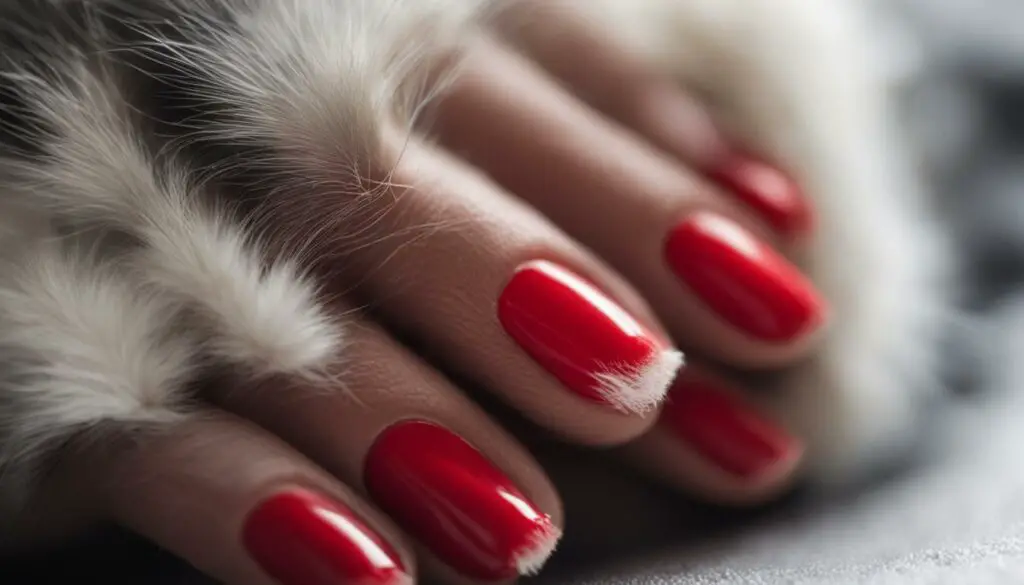
Remember, practice makes perfect, so don’t get discouraged if you don’t find the quick right away. Take your time, be patient, and work towards making nail trimming a positive experience for both you and your dog.
The Role of Positive Reinforcement in Nail Trimming
Nail trimming can be a stressful experience for our furry friends, but using positive reinforcement techniques can help create a positive association with this necessary grooming task. By incorporating rewards and treats during the nail trimming process, we can build trust and make the experience more enjoyable for our dogs.
During nail trimming sessions, I recommend having a bag of tasty treats nearby. Before starting, take a few moments to let your dog sniff and explore the nail clipper or grinder. Use a calm and reassuring tone of voice, and offer praise and treats for their cooperation. This helps to create a positive environment and build trust between you and your furry companion.
As you begin trimming their nails, remember to reward your dog with a treat after each successful clipping. This reinforces the idea that nail trimming leads to something positive. Additionally, if your dog becomes anxious or shows signs of stress during the process, take a break and offer more treats and praise or engage in a favorite play activity to redirect their focus.
“Using positive reinforcement techniques during nail trimming helps create a positive association with the process and builds trust between you and your furry companion.”
It’s important to note that positive reinforcement techniques may not work for every dog, especially those with severe anxiety or fear of nail trimming. In such cases, it is best to seek professional guidance from a veterinarian or professional groomer who can provide additional strategies and support.
Remember, the goal is to make nail trimming a positive and stress-free experience for both you and your dog. By incorporating positive reinforcement techniques, we can build a strong bond while ensuring our furry friends have well-maintained nails for their overall health and comfort.
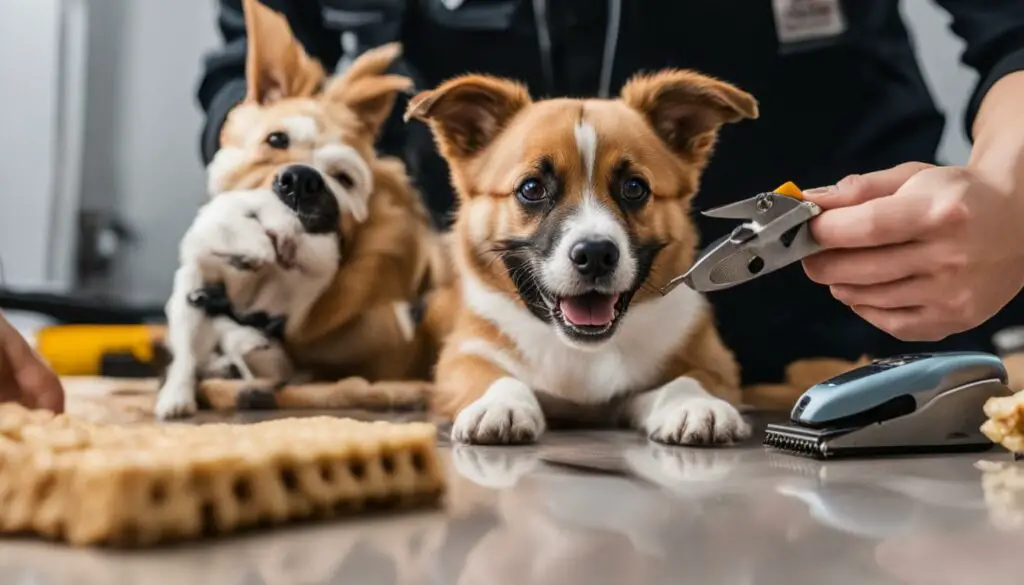
The Importance of Professional Guidance for Nail Trimming
When it comes to trimming your dog’s nails, seeking professional guidance can make a world of difference. Consulting a veterinarian or groomer for nail trimming not only ensures that the process is done correctly, but it also provides numerous benefits for both you and your furry friend.
One of the key advantages of professional guidance is the expertise they bring to the table. Veterinarians and groomers have extensive knowledge and experience in nail trimming, allowing them to accurately locate the quick on your dog’s nails and trim them safely. They can also offer professional tips and techniques that can make the process easier and more effective.
Additionally, professional guidance provides peace of mind. Nail trimming can be a daunting task, especially for pet owners who are new to it or feel unsure about the process. By consulting with a professional, you can have confidence in knowing that you’re taking the right steps to keep your dog’s nails healthy and well-maintained.
Furthermore, professionals can recommend the right tools and products for nail trimming. They can help you choose the best clippers or quick finder tools that are suitable for your dog’s specific needs. By using the right tools and techniques, you can minimize the risk of accidents or injuries during the nail trimming process.
Ultimately, while it’s possible to trim your dog’s nails at home, the importance of professional guidance should not be overlooked. By consulting a veterinarian or groomer, you can ensure that your dog’s nails are trimmed correctly, safely, and with minimal stress. It’s an investment in your dog’s well-being and can significantly contribute to their overall comfort and happiness.
Common Mistakes to Avoid When Finding the Quick on Dog Nails
When it comes to finding the quick on dog nails, there are a few common mistakes that pet owners should avoid. Making these mistakes can lead to pain, bleeding, and potentially even infection for your furry friend. To ensure a safe and successful nail trimming experience, here are some pitfalls to avoid:
1. Cutting Too Close to the Quick
One of the biggest mistakes pet owners make is cutting too close to the quick. The quick is the sensitive part of the nail that contains blood vessels and nerves. If you accidentally cut into the quick, it can cause your dog significant pain and bleeding. To avoid this, always trim your dog’s nails gradually and take frequent breaks to check for signs of the quick.
2. Neglecting to Use Proper Lighting
Proper lighting is crucial when trying to locate the quick, especially for dogs with dark-colored nails. Insufficient lighting can make it difficult to see the quick, increasing the risk of accidentally cutting into it. Make sure you are in a well-lit area and consider using a flashlight or a nail trimming tool with a built-in light to help you clearly see the quick.
3. Rushing the Process
Nail trimming can be a tedious task, but rushing through it can lead to mistakes. When you rush, you may be more likely to accidentally cut into the quick or miss it altogether. Take your time and be patient with your dog during the nail trimming process. If your dog becomes anxious or stressed, it’s important to take a break and resume trimming when they are calm and relaxed.
By avoiding these common mistakes, you can ensure a safer and more comfortable nail trimming experience for both you and your dog. Remember to always prioritize your dog’s well-being and consult a professional if you’re unsure about trimming your dog’s nails.
Additional Tips for Successful Nail Trimming
When it comes to trimming your dog’s nails, there are a few additional tips that can help make the process easier and more successful. These expert tips will ensure that you find the quick on your dog’s nails accurately and trim them safely.
1. Use proper lighting: Adequate lighting is crucial when locating the quick on your dog’s nails, especially for dogs with dark-colored nails. Make sure you have a well-lit area or use a flashlight to enhance visibility.
2. Take it slow: Rushing the nail trimming process can increase the chances of accidentally cutting into the quick. Take your time and trim a small amount of the nail at a time, gradually working your way closer to the quick.
3. Stay calm: Dogs are sensitive to their owner’s emotions, so it’s essential to remain calm and composed during nail trimming. If you’re feeling anxious or nervous, your dog may pick up on it and become stressed as well. Practicing deep breathing techniques can help keep both you and your dog relaxed.
4. Use treats as rewards: Positive reinforcement is key to creating a positive association with nail trimming. Reward your dog with small, tasty treats after each successful nail trimming session to make it an enjoyable experience for them.
5. Seek professional advice: If you’re unsure about finding the quick on your dog’s nails or trimming them safely, don’t hesitate to seek professional guidance. Veterinarians and professional groomers can provide expert advice and demonstrate the proper techniques for nail trimming.
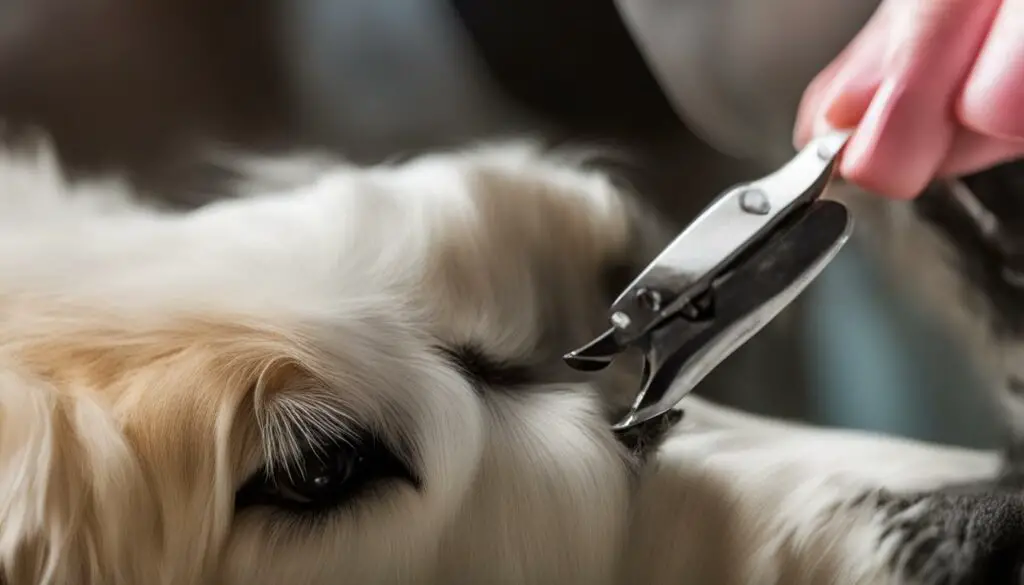
Expert Advice on Trimming Dog’s Nails
“Finding the quick on dog nails can be challenging, but with patience, proper lighting, and taking it slow, you can do it. Remember to reward your dog with treats and seek professional advice if needed.”
By following these additional tips and seeking expert advice when necessary, you can ensure a successful nail trimming experience for both you and your dog. Remember, finding the quick on your dog’s nails is essential for their comfort and well-being, so take the time to locate it accurately before trimming. With practice, patience, and positive reinforcement, you’ll become a pro at trimming your dog’s nails and keeping them healthy and happy.
The Benefits of Regular Nail Trimming
Regular nail trimming is an essential part of a dog’s grooming routine and offers numerous benefits for their health and well-being. By keeping their nails properly trimmed, you can ensure their comfort and prevent potential issues that may arise from long nails. Here are some of the key advantages of regular nail trimming for dogs:
- Pain and Discomfort Prevention: Overgrown nails can cause pain and discomfort for dogs, especially when walking or running. Regular trimming helps prevent nails from becoming too long and reduces the risk of nail-related injuries.
- Improved Mobility and Posture: Long nails can affect a dog’s gait and posture, leading to changes in their movement and causing strain on their joints. By keeping their nails at an appropriate length, you can promote proper mobility and reduce the risk of musculoskeletal issues.
- Prevention of Infections and Injuries: When nails are too long, they can break or split, potentially causing open wounds that can become infected. Regular trimming helps prevent such injuries and reduces the risk of infections.
- Maintaining Healthy Paw Structure: Properly trimmed nails contribute to maintaining the overall health and structure of a dog’s paws. Overgrown nails can push the toes apart, leading to imbalances and deformities over time.
Regular nail trimming should be part of every dog owner’s care routine. It not only promotes the well-being of dogs but also contributes to their overall comfort and quality of life. By establishing a regular nail care routine and ensuring that nails are kept at an appropriate length, you can help your furry friend stay happy and healthy.
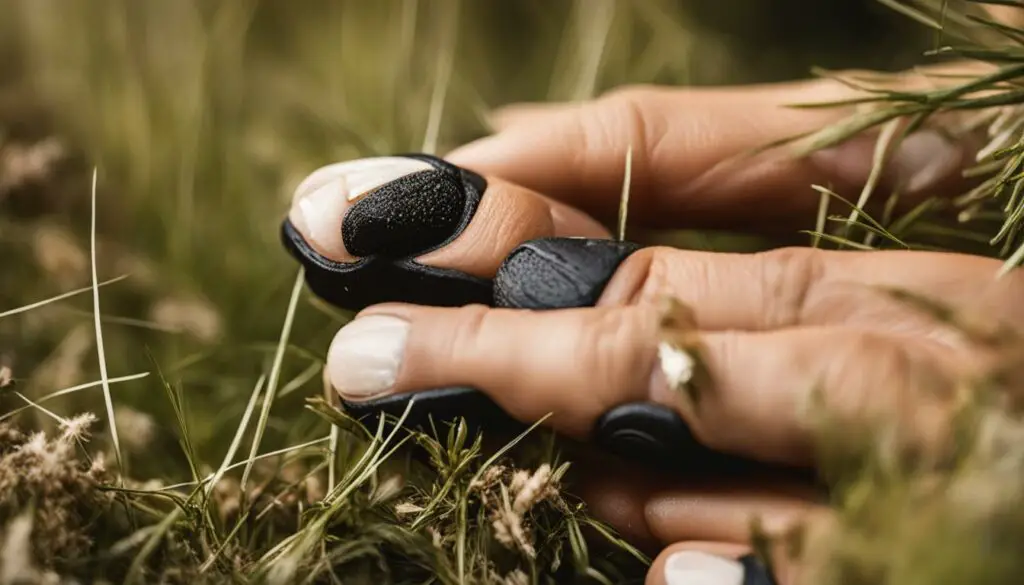
Table: Comparing the Benefits of Different Nail Trimming Frequencies
| Frequency | Advantages |
|---|---|
| Weekly |
|
| Bi-weekly |
|
| Monthly |
|
Conclusion
In conclusion, mastering the art of finding the quick on dog nails is essential for their health and well-being. By following the step-by-step guide provided in this article, you can safely and effectively trim your dog’s nails at home. Remember to always prioritize their comfort and avoid cutting into the quick to prevent pain and bleeding.
Regular nail trimming is crucial for maintaining your dog’s overall health and preventing issues such as infections and gait abnormalities. By keeping their nails at a manageable length, you can ensure their comfort and reduce the risk of nails breaking or splitting.
Seeking professional guidance is recommended, especially if you’re a beginner or unsure about the process. A veterinarian or professional groomer can provide expert tips on finding the quick, recommend the right tools, and offer techniques for safe and effective nail trimming.
With practice, patience, and positive reinforcement techniques, you can successfully find the quick on your dog’s nails and contribute to their happy and healthy paws. So, take the time to master the art of nail trimming, and your furry friend will thank you!
FAQ
Why is clipping a dog’s nails regularly important?
Clipping a dog’s nails regularly is important to prevent pain, discomfort, and potential health issues. Long nails can cause infections, gait abnormalities, and affect a dog’s posture and mobility.
How can I find the quick on a dog’s nails?
Finding the quick on a dog’s nails can be challenging, especially for dogs with dark-colored nails. Some tips include looking for the pink area in light-colored nails and using a flashlight to locate the quick in dark-colored nails.
What tools do I need to find the quick on dog nails?
Essential tools for finding the quick on dog nails include nail clippers, a nail file, styptic powder or cornstarch for emergencies, and a flashlight for dogs with dark-colored nails.
Can I safely trim my dog’s nails at home?
It is possible to trim your dog’s nails at home, but it is important to seek professional guidance, especially if you are a beginner or unsure about the process. A veterinarian or professional groomer can provide expert tips and advice.
What are some common mistakes to avoid when finding the quick on dog nails?
Common mistakes to avoid when finding the quick on dog nails include cutting into the quick, not using proper nail trimming tools, and not trimming the nails regularly enough.
Are there any additional tips for successful nail trimming?
Some additional tips for successful nail trimming include using positive reinforcement techniques, trimming a small amount of nail at a time, and seeking professional advice if needed.
What are the benefits of regular nail trimming?
Regular nail trimming offers benefits such as maintaining healthy paw structure, reducing the risk of nails breaking or splitting, and overall comfort for the dog.


